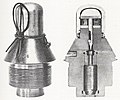Datei:No106FuzeSectionPhoto.jpg
Zur Navigation springen
Zur Suche springen

Größe dieser Vorschau: 712 × 600 Pixel. Weitere Auflösungen: 285 × 240 Pixel | 570 × 480 Pixel
Originaldatei (800 × 674 Pixel, Dateigröße: 109 KB, MIME-Typ: image/jpeg)
Dateiversionen
Klicke auf einen Zeitpunkt, um diese Version zu laden.
| Version vom | Vorschaubild | Maße | Benutzer | Kommentar | |
|---|---|---|---|---|---|
| aktuell | 08:12, 5. Jul. 2008 |  | 800 × 674 (109 KB) | Rcbutcher | {{Information |Description= |Source= |Date= |Author= |Permission= |other_versions= }} |
| 12:48, 29. Jun. 2008 |  | 640 × 534 (200 KB) | Rcbutcher | {{Information |Description=Photograph showing sectioned British No. 106 direct-action percussion fuze, World War I vintage. |Source=British ordnance manual circa. 1916-1918 |Date=circa. 1916-1918 |Author=War Office, UK |Permission=Crown copyright expired |
Dateiverwendung
Die folgende Seite verwendet diese Datei:
Globale Dateiverwendung
Die nachfolgenden anderen Wikis verwenden diese Datei:
- Verwendung auf da.wikipedia.org
- Verwendung auf en.wikipedia.org
- Verwendung auf lt.wikipedia.org
- Verwendung auf pl.wikipedia.org
- Verwendung auf pt.wikipedia.org
- Verwendung auf ru.wiktionary.org
- Verwendung auf uk.wikipedia.org
- Verwendung auf www.wikidata.org
